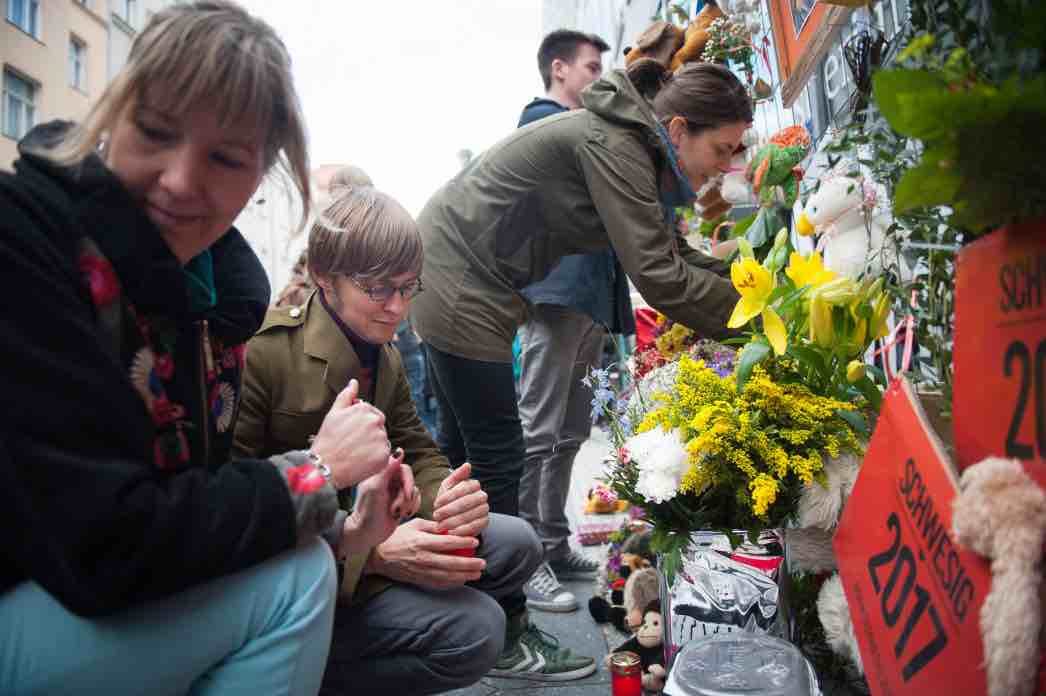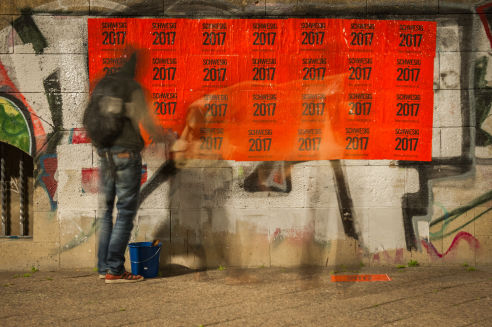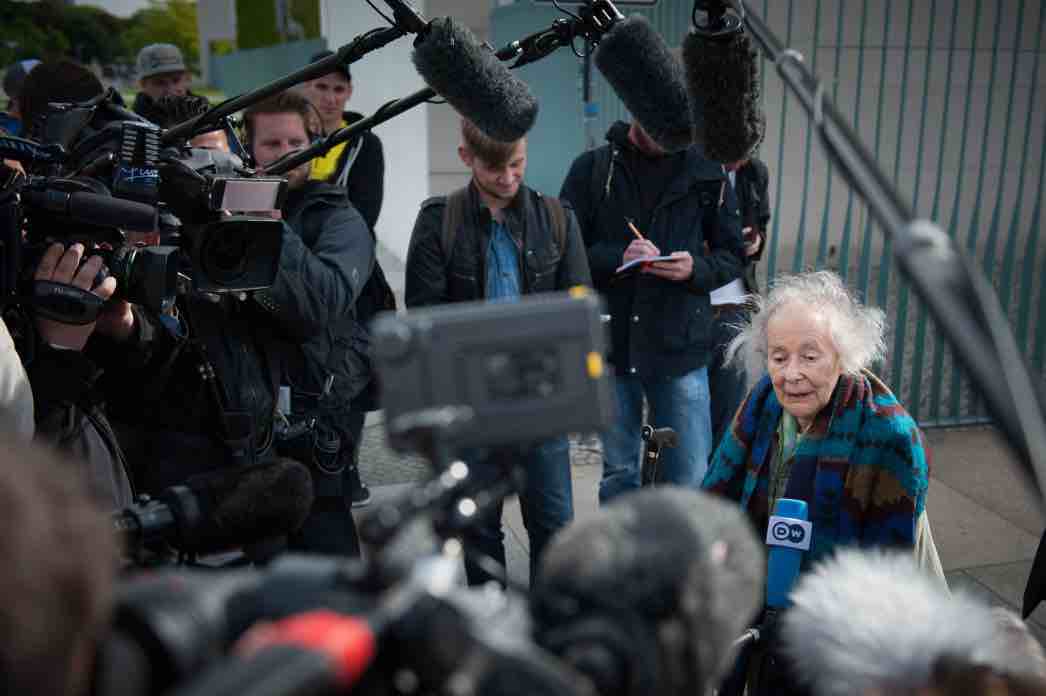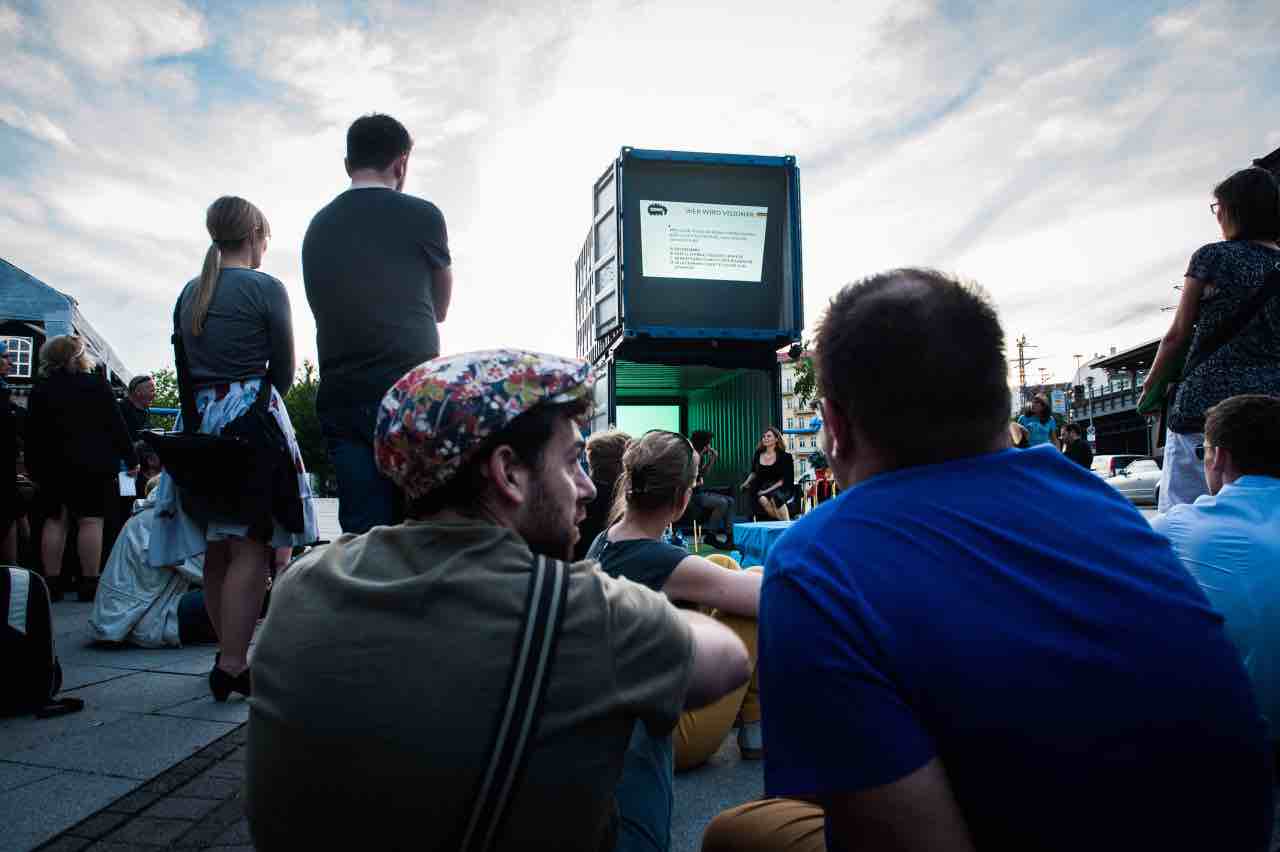
Saving lives can be so simple – if one truly wants to. The German government rescues 55,000 Syrian children from the war with a ready-to-use Emergency Programme developed by the Center for Political Beauty. According to UNICEF, 5.5 million Syrian children are in acute need of help. Thanks to the Federeal Kindertransporte, 55,000 children (»One in a Hundred«) can be temporarily admitted to Germany. With the full authority of the federal government and the Ministry of Family Affairs, we looked for foster families in order to remind of the apocalyptical situation in Syria.


A Minister of Family Affairs wants to do more than talk and listen. Her resolute action improves Germany’s image abroad. Even Madeleine Albright (whose cousin survived the holocaust thanks to the Kindertransport) says: »Minister Schwesig’s courage deserves our respect!«


The website is launched on a Monday. Those who are interested in the programme can call around the clock for more information. Six actors answer the phone calls. The German media show a keen interest. Within one week, 800 families applied to take a Syrian child into care – even though the artistic nature of the campaign was openly declared. The government is exposed. Saving lives is not part of their understanding of politics.
»A drastic art campaign!«

»An extraordinary idea!«

»Assault troop of aggressive humanism!«

Welcome to hyperrealism: No cynicism. No irony. Just the naked truth changing reality. Two days after the launch, the government is forced to announce that it intends to take in more Syrian refugees.
Grateful citizens gather in front of the Ministry of Family Affairs to lay down flowers, teddy bears and »thank you« notes. Unusual images in the political circles of Germany’s capital. Images that are usually associated with Buckingham Palace: the German population lays down a sea of flowers in front of the Ministry of Family Affairs. Minister Schwesig, however, has not yet publicly commented on the campaign.
The Emergency Programme’s initiator, Isabelle von Ohoven, accepts people’s gifts on behalf of the Minister: »Ms. Schwesig doesn’t like to boast. She does not want to talk about the good things she does!«
Anticipating the future: Manuela Schwesig wins the power struggle against Sigmar Gabriel within her party and becomes the SPD’s candidate for Federal Chancellor at the 2017 general elections. Schwesig revives her party’s trademark: cross-border solidarity. The electoral campaign starts in May 2014 in all large German cities.









Minister for Family Affairs Manuela Schwesig is being hailed as a hero by the entire German population. And not only that: even children from the Salaheddin district in Aleppo thank the Minister for her rescue programme – directly from the frontline trapped between rebels and Assad’s forces.
The only catch: Manuela Schwesig did not spend any time thinking about the destiny of these children or the apocalyptical situation of the Syrian population. She is suffocated with love. A Minister of Family Affairs faces a choice: cold-heartedness or political beauty.





For the local Berlin press it is the highlight of year. When was the last time that theatre producers were invited into the Chancellery within 48 hours? Together with Inge Lammel and Kurt Gutmann – two survivors of the Holocaust, who were brought to the UK and rescued shortly before the war broke out – we enter the stronghold of Europe’s defense against refugees. Despite high pressure from the media, the Chancellery remains stubborn and does not let the press attend the meeting.





History is seldom told in connection to the political present. The Kindertransport is used as a blueprint and therefore so closely linked to the present that it hurts. The Allied forces reacted to one of the worst refugee crises of the 20th century by drastically tightening immigration rules and regulations. Instead of using diplomacy to help those who were persecuted, Great Britain reintroduced the visa obligations previously abolished in 1927. »The world seemed to be divided into two parts – those places where the Jews could not live, and those where they could not enter«, said Chaim Waizman in 1936. The climax of American refugee deterrence was the turning away of the St Louis passenger ship carrying 906 refugees.
Supported by History: members of the Ministry of Family Affairs try to recruit potential foster families for Syrian children. In the slipstream of history, a memorial at Bahnhof Friedrichstrasse commemorates the British government’s unique decision to take almost 10,000 children out of Germany in 1938/1939.
Almost 300,000 people walk past the memorial every day without paying attention. In front of the memorial, the Ministry of Family Affairs set up an information centre for the Federal Emergency Programme. The goal: assessing the chances for today’s Kindertransport. Thousands of passersby took leaflets, information material and application forms.






With historic eye for detail, the British Kindertransport was adapted to the German reality of 2014. In the video on the left, a member of the Ministry of Family Affairs says in Arabic the exact same sentences that were used for thousands of German mothers in 1938.
The story of the Kindertransport is first and foremost a story of the destruction of German Jewish families and secondly the story of a transitory crack in the wall of the Allied defense against refugees. In the video on the right, Kurt Guttmann calls on the solidarity of the Minister of Family Affairs.
Historian Claudia Curio draws the following conclusion: the world’s willingness to accept refugees decreased with an increasing number of refugees coming from Germany. For Rebekka Göpfert, the distinctive feature of the Kindertransport was that »it issued visa at a time where the whole world, with only a few exceptions, closed its borders for German Jews«.
At a breathtaking pace, the admittance of child refugees was approved. Between the British government’s political decision to take in children at risk and the arrival of the first Kindertransport were only two (!) weeks. The initiative was marked by the British population’s unparalleled willingness to help. One month after the first transport, 2,500 letters of commitment for the accommodation of children were signed. Bearing in mind the annihilation of Jews in the Holocaust, the Kindertransport retrospectively turned into a choice between life and death.





The Aleppo poster below in Arabic prohibits parents to accompany their children to the bus station. Another analogy to German history.


Björn Höcke has praised the Center for Political Beauty as a »terrorist group«. Get close to the action and become an accomplice to a terrorist organization so far sadly recognized only by Höcke, Erdogan, and the Free State of Thuringia! As an accomplice you will make an invaluable contribution to inciting public unrest in the service of aggressive humanism. Nowhere else will you receive more unrest and dissent for every donated Euro.


Germany no longer wants to turn a blind eye to the Syrian apocalypse. The federal government wants to save one in a hundred Syrian children. Within eyeshot from the Kindertransport memorial, a new monument weighing 4.4 tons is erected against the mortal fears and danger of Syrian children. A fast breeder of human solidarity. The videos on the memorial were shown 24 hours a day and put Berlin in a state of emergency over five days. War came right in front of the gates to the government quarters.
General conviction: Germany cannot save all the world’s problems. But it can help one in a hundred children. People were able to vote for one of the children. But they were not able to save more than one child. Because the federal government is not omnipotent. It cannot save »all the world’s problems« (Thomas de Maizière). But it can save one in a hundred. One child wins. 99 continue to die. All videos can be found under: voting.1aus100.de.
In front of this new memorial, Syrian refugees tell their stories. The horrified audience is afterwards treated in a first aid tent. Tens of thousands of people were confronted with the betrayal of civilisation that currently takes place in Syria: densely populated metropolises are arbitrarily attacked by barrel bombs.







The biggest humanitarian disaster of the 21st century up until now: 13 million refugees, 5.5 million children, approximately 200,000 casualties (as of 2014). Dictator Assad systematically besieges, starves and bombs more than 40 areas in Syria. The Syrian population is killed in slow motion right in front of our eyes. Assad’s troops besiege entire city districts and cut them off from humanitarian aid and medical care. After being banned from using chemical weapons, Assad now counts on starvation and air strikes. The population is completely exhausted. Give us food so that we can survive and we will renonce everything we hoped for: democracy, human rights and liberty.
Assad drops »barrel bombs« on besieged towns. As their name suggest, barrel bombs are old oil barrels filled with explosives, nails and shrapnel that are meant to kill or wound as many people as possible. This is what the betrayal of civilisation looks like in Syria: two-year old Ghina Bassam was unconscious when she was dug out of the debris that was once her room. The barrel bomb attack killed her mother and one of her sisters. The girl survived as if through a miracle. She is no exception. There are thousands of these images. The next generation will see them and ask: how could our parents let this happen? The German Minister of Foreign Affairs will fly to Syria to take part in a commemorative conference and pledge in a passionate speech that this must NEVER happen again. What is happening in Syria is not an ordinary crisis. Syria is the largest political crime that has been committed in decades.
Center for Political Beauty
Various languages
Cormac Walsh Hoax Website Pressures German Government to Act on Syrian Child Refugees
DW Holocaust survivors demand help for Syrian refugees
Global Post Day 1,156: Artists want to save Syria's children by fostering them in German homes
Ha‘aretz Holocaust survivors call on Germany to take in more Syrian refugees
MyEurope (Französisch) Un faux ministère allemand pour sauver de vraies vies syriennes
DW (Französisch) Sauver un enfant syrien sur cent
DW ألمانيا - "تزوير نبيل" من أجل أطفال سوريا
All4Syria ألمانيا: حملة من أجل استقبال 55 الف طفل سوري تحولت لتشكل ضغط على الحكومة ؟
Al Hayat خدعة فنية لحضّ ألمانيا على دعم أطفال سورية (pdf)
Pressenza (Spanisch) 55.000 niños sirios serán evacuados de la zona de guerra a Alemania



